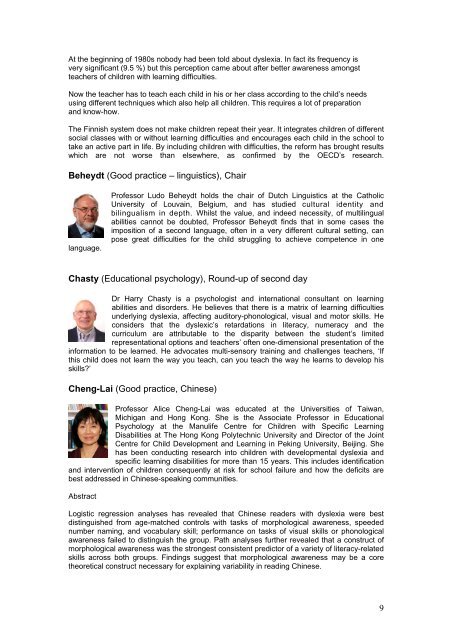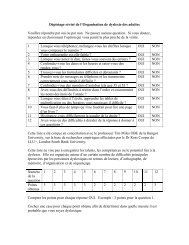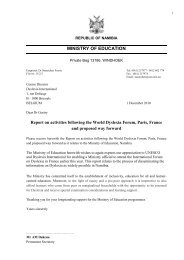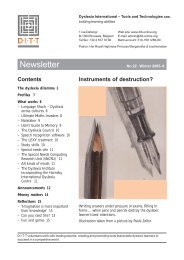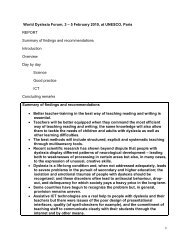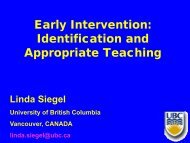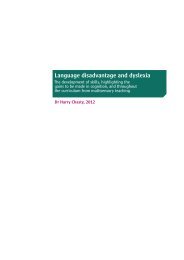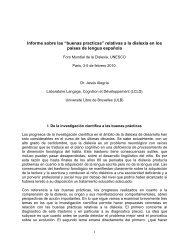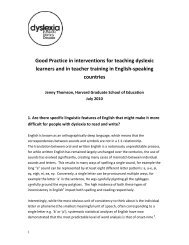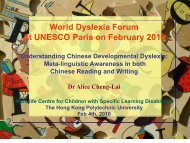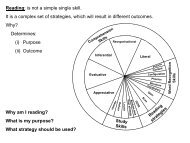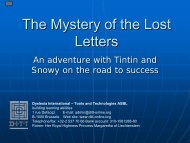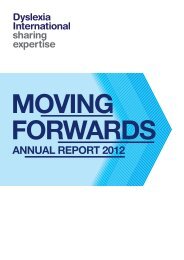Best practice in the teaching of reading and writing - Dyslexia ...
Best practice in the teaching of reading and writing - Dyslexia ...
Best practice in the teaching of reading and writing - Dyslexia ...
You also want an ePaper? Increase the reach of your titles
YUMPU automatically turns print PDFs into web optimized ePapers that Google loves.
At <strong>the</strong> beg<strong>in</strong>n<strong>in</strong>g <strong>of</strong> 1980s nobody had been told about dyslexia. In fact its frequency is<br />
very significant (9.5 %) but this perception came about after better awareness amongst<br />
teachers <strong>of</strong> children with learn<strong>in</strong>g difficulties.<br />
Now <strong>the</strong> teacher has to teach each child <strong>in</strong> his or her class accord<strong>in</strong>g to <strong>the</strong> child’s needs<br />
us<strong>in</strong>g different techniques which also help all children. This requires a lot <strong>of</strong> preparation<br />
<strong>and</strong> know-how.<br />
The F<strong>in</strong>nish system does not make children repeat <strong>the</strong>ir year. It <strong>in</strong>tegrates children <strong>of</strong> different<br />
social classes with or without learn<strong>in</strong>g difficulties <strong>and</strong> encourages each child <strong>in</strong> <strong>the</strong> school to<br />
take an active part <strong>in</strong> life. By <strong>in</strong>clud<strong>in</strong>g children with difficulties, <strong>the</strong> reform has brought results<br />
which are not worse than elsewhere, as confirmed by <strong>the</strong> OECD’s research.<br />
Beheydt (Good <strong>practice</strong> – l<strong>in</strong>guistics), Chair<br />
language.<br />
Pr<strong>of</strong>essor Ludo Beheydt holds <strong>the</strong> chair <strong>of</strong> Dutch L<strong>in</strong>guistics at <strong>the</strong> Catholic<br />
University <strong>of</strong> Louva<strong>in</strong>, Belgium, <strong>and</strong> has studied cultural identity <strong>and</strong><br />
bil<strong>in</strong>gualism <strong>in</strong> depth. Whilst <strong>the</strong> value, <strong>and</strong> <strong>in</strong>deed necessity, <strong>of</strong> multil<strong>in</strong>gual<br />
abilities cannot be doubted, Pr<strong>of</strong>essor Beheydt f<strong>in</strong>ds that <strong>in</strong> some cases <strong>the</strong><br />
imposition <strong>of</strong> a second language, <strong>of</strong>ten <strong>in</strong> a very different cultural sett<strong>in</strong>g, can<br />
pose great difficulties for <strong>the</strong> child struggl<strong>in</strong>g to achieve competence <strong>in</strong> one<br />
Chasty (Educational psychology), Round-up <strong>of</strong> second day<br />
Dr Harry Chasty is a psychologist <strong>and</strong> <strong>in</strong>ternational consultant on learn<strong>in</strong>g<br />
abilities <strong>and</strong> disorders. He believes that <strong>the</strong>re is a matrix <strong>of</strong> learn<strong>in</strong>g difficulties<br />
underly<strong>in</strong>g dyslexia, affect<strong>in</strong>g auditory-phonological, visual <strong>and</strong> motor skills. He<br />
considers that <strong>the</strong> dyslexic’s retardations <strong>in</strong> literacy, numeracy <strong>and</strong> <strong>the</strong><br />
curriculum are attributable to <strong>the</strong> disparity between <strong>the</strong> student’s limited<br />
representational options <strong>and</strong> teachers’ <strong>of</strong>ten one-dimensional presentation <strong>of</strong> <strong>the</strong><br />
<strong>in</strong>formation to be learned. He advocates multi-sensory tra<strong>in</strong><strong>in</strong>g <strong>and</strong> challenges teachers, ‘If<br />
this child does not learn <strong>the</strong> way you teach, can you teach <strong>the</strong> way he learns to develop his<br />
skills’<br />
Cheng-Lai (Good <strong>practice</strong>, Ch<strong>in</strong>ese)<br />
Pr<strong>of</strong>essor Alice Cheng-Lai was educated at <strong>the</strong> Universities <strong>of</strong> Taiwan,<br />
Michigan <strong>and</strong> Hong Kong. She is <strong>the</strong> Associate Pr<strong>of</strong>essor <strong>in</strong> Educational<br />
Psychology at <strong>the</strong> Manulife Centre for Children with Specific Learn<strong>in</strong>g<br />
Disabilities at The Hong Kong Polytechnic University <strong>and</strong> Director <strong>of</strong> <strong>the</strong> Jo<strong>in</strong>t<br />
Centre for Child Development <strong>and</strong> Learn<strong>in</strong>g <strong>in</strong> Pek<strong>in</strong>g University, Beij<strong>in</strong>g. She<br />
has been conduct<strong>in</strong>g research <strong>in</strong>to children with developmental dyslexia <strong>and</strong><br />
specific learn<strong>in</strong>g disabilities for more than 15 years. This <strong>in</strong>cludes identification<br />
<strong>and</strong> <strong>in</strong>tervention <strong>of</strong> children consequently at risk for school failure <strong>and</strong> how <strong>the</strong> deficits are<br />
best addressed <strong>in</strong> Ch<strong>in</strong>ese-speak<strong>in</strong>g communities.<br />
Abstract<br />
Logistic regression analyses has revealed that Ch<strong>in</strong>ese readers with dyslexia were best<br />
dist<strong>in</strong>guished from age-matched controls with tasks <strong>of</strong> morphological awareness, speeded<br />
number nam<strong>in</strong>g, <strong>and</strong> vocabulary skill; performance on tasks <strong>of</strong> visual skills or phonological<br />
awareness failed to dist<strong>in</strong>guish <strong>the</strong> group. Path analyses fur<strong>the</strong>r revealed that a construct <strong>of</strong><br />
morphological awareness was <strong>the</strong> strongest consistent predictor <strong>of</strong> a variety <strong>of</strong> literacy-related<br />
skills across both groups. F<strong>in</strong>d<strong>in</strong>gs suggest that morphological awareness may be a core<br />
<strong>the</strong>oretical construct necessary for expla<strong>in</strong><strong>in</strong>g variability <strong>in</strong> read<strong>in</strong>g Ch<strong>in</strong>ese.<br />
9


